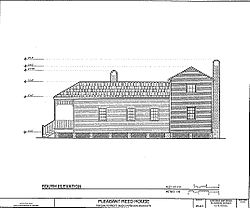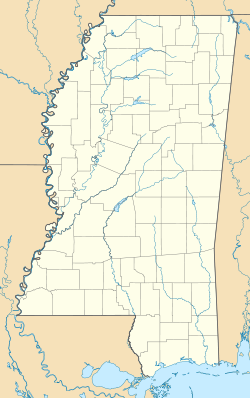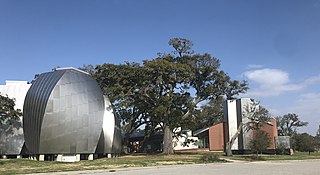
Biloxi is a city in Harrison County, Mississippi, United States. It lies on the Gulf Coast in southern Mississippi thirteen miles east of Gulfport along US-90. The adjacent cities are both designated as seats of Harrison County. The population of Biloxi was 49,449 at the 2020 census, making it the state's fourth-largest city. It is a principal city of the Gulfport–Biloxi metropolitan area, home to 416,259 residents in 2020. The area's first European settlers were French colonists.

The Beauvoir estate, built in Biloxi, Mississippi, along the Gulf of Mexico, was the post-war home (1876–1889) of the former President of the Confederate States of America Jefferson Davis. The National Park Service designated the house and plantation as a National Historic Landmark.
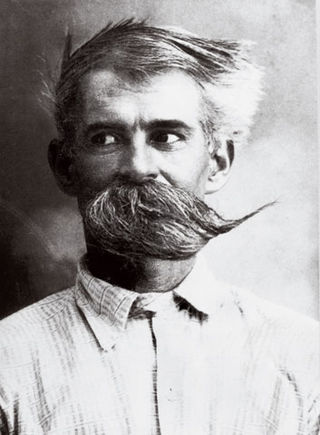
George Edgar Ohr was an American ceramic artist and the self-proclaimed "Mad Potter of Biloxi" in Mississippi. In recognition of his innovative experimentation with modern clay forms from 1880 to 1910, some consider him a precursor to the American Abstract-Expressionism movement.

Willamette Heritage Center is a museum in Salem, Oregon. The five-acre site features several structures listed on the National Register of Historic Places including the Thomas Kay woolen mill, the Jason Lee House, Methodist Parsonage, John D. Boon House, the Pleasant Grove (Condit) Church. The houses and church were relocated to the mill site. The Center also includes a research library and archives of Marion County history.

Charles A. Lindbergh State Park is a 569-acre (2.3 km2) Minnesota state park on the outskirts of Little Falls. The park was once the farm of Congressman Charles August Lindbergh and his son Charles Lindbergh, the famous aviator. Their restored 1906 house and two other farm buildings are within the park boundaries. The house, a National Historic Landmark, and an adjacent museum are operated by the Minnesota Historical Society, known as the Charles Lindbergh House and Museum. Three buildings and three structures built by the Works Progress Administration in the 1930s were named to the National Register of Historic Places. These buildings include a picnic shelter and a water tower, built in the Rustic Style from local stone and logs, and have remained relatively unchanged since construction. Although the property includes shoreline on the Mississippi River, the Lindbergh family requested that the park not include intensive use areas for swimming or camping, so development was kept to a minimum.

Eugene James Martin was an African-American visual artist.

The Mark Twain Boyhood Home & Museum is located on 206-208 Hill Street, Hannibal, Missouri, on the west bank of the Mississippi River in the United States. It was the home of Samuel Langhorne Clemens, better known as author Mark Twain, from 1844 to 1853. Clemens found the inspiration for many of his stories, including the white picket fence, while living here. It has been open to the public as a museum since 1912, and was designated a National Historic Landmark on December 29, 1962. It is located in the Mark Twain Historic District.

Salmon Ruins is an ancient Chacoan and Pueblo site located in the northwest corner of New Mexico, USA. Salmon was constructed by migrants from Chaco Canyon around 1090 CE, with 275 to 300 original rooms spread across three stories, an elevated tower kiva in its central portion, and a great kiva in its plaza. Subsequent use by local Middle San Juan people resulted in extensive modifications to the original building, with the reuse of hundreds of rooms, division of many of the original large, Chacoan rooms into smaller rooms, and emplacement of more than 20 small kivas into pueblo rooms and plaza areas. The site was occupied by ancient Ancestral Puebloans until the 1280s, when much of the site was destroyed by fire and abandoned. The pueblo is situated on the north bank of the San Juan River, just to the west of the modern town of Bloomfield, New Mexico, and about 45 miles (72 km) north of Pueblo Bonito in Chaco Canyon. The site was built on the first alluvial terrace above the San Juan River floodplain.
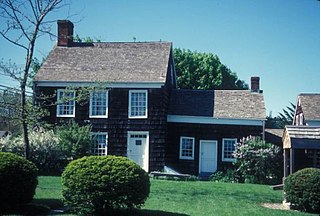
The Walt Whitman Birthplace State Historic Site is a state historic site in West Hills, New York, listed on the National Register of Historic Places. The site preserves the birthplace of American poet Walt Whitman.

The Lucius Quintus Cincinnatus Lamar House is a historic house museum at 616 North 14th Street in Oxford, Mississippi. Its mission is "to interpret the life and career of the distinguished 19th-century statesman L.Q.C. Lamar within the context of his times and to encourage the ideal of statesmanship in the 21st century". Admission is free and open to the public Fridays, Saturdays, and Sundays from 1-4 pm unless otherwise advertised. The house was designated a National Historic Landmark in 1975.
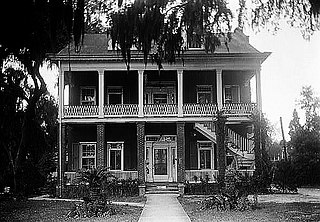
Tullis-Toledano Manor, also known as, the Toledano-Philbrick-Tullis House, was a red-clay brick mansion on the Mississippi Gulf Coast in Biloxi. It was considered an example of Greek Revival architecture. The mansion was added to the National Register of Historic Places in 1976 and was destroyed by Hurricane Katrina in 2005.
A Mississippi Landmark is a building officially nominated by the Mississippi Department of Archives and History and approved by each county's chancery clerk. The Mississippi Landmark designation is the highest form of recognition bestowed on properties by the state of Mississippi, and designated properties are protected from changes that may alter the property's historic character. Currently there are 890 designated landmarks in the state. Mississippi Landmarks are spread out between eighty-one of Mississippi's eighty-two counties; only Issaquena County has no such landmarks.
James Eugene Howarth is an American former professional baseball outfielder who appeared in 152 games played in the Major Leagues over all or part of four seasons, from 1971 to 1974, for the San Francisco Giants. He threw and batted left-handed, and was listed as 5 feet 11 inches (1.80 m) tall and 175 pounds (79 kg).
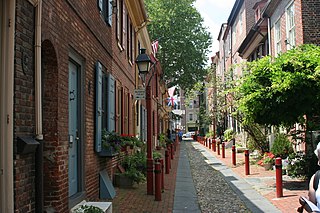
Elfreth's Alley is an historic street in the Old City neighborhood of Philadelphia, Pennsylvania, dating to 1703. The street has 32 houses, built between 1703 and 1836. The Elfreth's Alley Museum is located at #124 and 126.
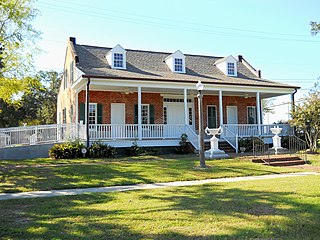
The Old Brick House, also known as Biloxi Garden Center, was built around 1850 as a modest family home by John Henley, a former sheriff and mayor of Biloxi. The house is situated on Back Bay in Biloxi, Mississippi. The home was added to the National Register of Historic Places in 1973, and was designated a Mississippi Landmark in 1987. Although heavily damaged by Hurricane Katrina in 2005, the house was restored and re-dedicated in 2011.

Jeremiah Joseph O'Keefe III was an American fighter ace, Democratic Party politician, insurance executive, and funeral director. As a Marine pilot in World War II he received the Navy Cross for five of the seven kills he recorded over Okinawa. After the war he entered politics, serving as a member of the Mississippi House of Representatives from 1960 to 1964 and as the mayor of Biloxi, Mississippi, from 1973 to 1981. The most prominent funeral home owner in Biloxi, he won a $500 million jury award in a contractual dispute with the rival funeral home company Loewen Group, later settling for $175 million.

Dusti Bongé was an American painter who worked from the 1930s through the early 1990s. She is considered Mississippi's first Abstract Expressionist painter and its first Modernist artist.
Carl Joe Williams is an American visual artist based in New Orleans.
